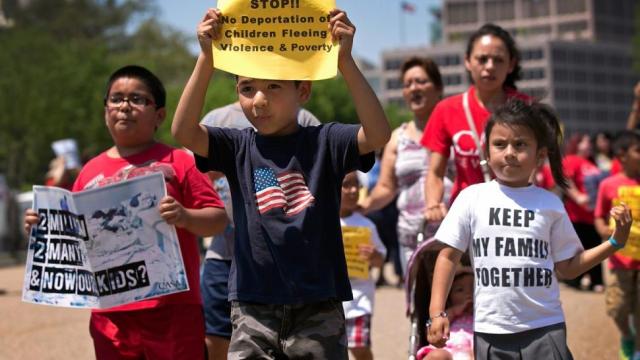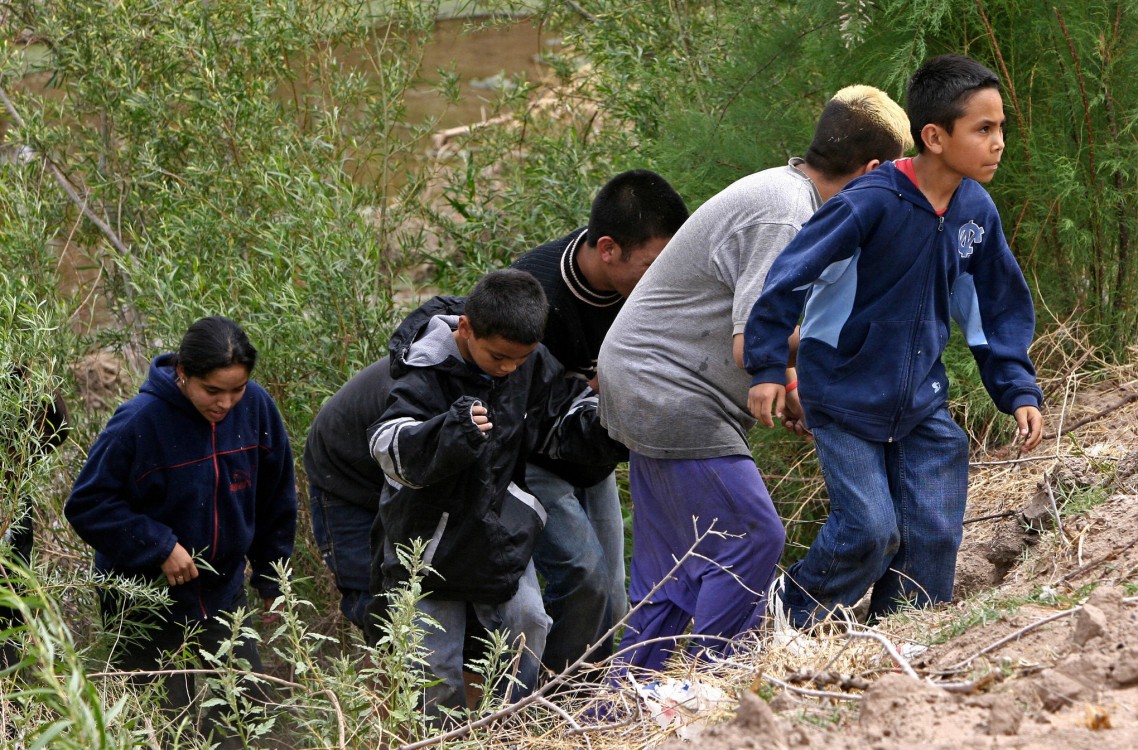
Around 1212 A.D., so the story goes, as many as 30,000 children embarked from Europe on a crusade to the Holy Land in order to peacefully convert the Muslims to Christianity. Those who didn’t die on the voyage were then said to have been sold into slavery in Tunisia by unscrupulous merchants who had offered them free passage across the sea.
Most contemporary scholars believe that this mass movement was actually a series of migrations of people of all ages for a life away from the grinding poverty and violence of their home countries. In this, it parallels what has been going on along America’s southern border this past summer as wave after wave of children and young adults arrived, most of them from three small Central American countries.
Once the influx had begun, the news reports and political posturing came fast and furious (no pun intended). Some commentators were sympathetic, some were worried and some were downright paranoid, but the coverage of the story was almost always lurid. In this regard, special mention has to be made of radio host Alex Jones, who managed to update the narrative with fears of Ebola and the militant group ISIS coming over the border.
The mainstream media also failed to mention that neighboring countries like Panama and Costa Rica had received immigrant influxes of their own. What is going on in these three countries – Honduras, Guatemala and El Salvador – that their kids continue to leave en masse?
A Little Background
First of all it should be remembered that many of these migrants had some kind of family tie in the U.S. By putting the media hysteria aside, we can look at some of the history behind this tragic story and the reasons why so many kids continue to make this dangerous trek. Get ready for a wild ride that encompasses the War on Drugs, Reagan-era civil wars and a U.S. sponsored coup.
I spent some time in Guatemala in the 90s and I found a country that was still dealing with the remnants of a civil war or, as many observers described it, a genocide. At least 200,000 people died during the government‘s “counterinsurgency” campaign. It was a war that the state had declared against its own people and “won.” I saw the whole country by bus and standing on the back of a pickup truck and in this capacity it was pretty easy to see the huge divide separating the (mostly indigenous Mayan) poor and the (surprisingly European-looking) rich as well as the total impunity with which the security forces interacted with the public.
El Salvador was also riven by a civil war, fought by the leftist FMLN against that country’s entrenched oligarchy. It went on for more than 35 years and resulted in some 75,000 deaths as reported by James North in The Nation last summer. Among the dead was Oscar Romero, the Archbishop of San Salvador and a popular liberation theologist who was assassinated while giving mass. It wasn’t lost on those who were paying attention that the Iraq Surge was also called “the Salvador Option” by policy makers, who saw the slaughter of civilians by extra-judicial death squads as a way to “success” in that conflict.
The third country, Honduras, was considered an island of peace in a region mired in war and counter-insurgency, although it shared many of the repressive characteristics of its neighbors. This illusion of stability was, I believe, a direct result of the massive, mostly military aid the country received due to its usefulness as a staging ground for the Nicaraguan Contras – so beloved by Ronald Reagan’s administration during the 1980s.
These wars, along with terrible economic conditions, produced at least a million refugees between 1981 and 1990 according to a reportissued by the non-profit Migration Policy Institute in April of 2006. Many of these refugees settled in Los Angeles and its environs. After a similar hysteria (less abetted by talk radio and the internet), those that weren’t deported settled into their new lives in America as had so many immigrant groups before them.
Like these earlier immigrants, they faced obstacles in adapting to their new home and young males formed gangs as much for mutual protection as for profit. The two biggest were called MS13 and a splinter that developed from it, Calle 18. One difference between them and the Irish, Italians and other groups who had pretty much done the same thing in the late 19th and early 20th century was that “...the U.S. government began aggressively deporting migrants with criminal records, including young gang members, particularly after a 1996 immigration-reform measure...” as reported by AZCentral.com in July. The article also noted that the Feds didn’t bother to inform the gang members' countries of origin about their criminal records before deporting them.
More often than not, these deported gang members had scarce recollections of the countries from whence they came and some continued their criminal activities in their home countries, joining up with local gangs or forming their own based on those they had affiliated with in the States. They were soon connected to the ruthless Mexican drug cartels who saw an advantage in using these newly powerful groups as mules for their product, be it people or narcotics.
In a breathless piece in the April/May 2005 issue of Foreign Policy, entitled “How the Street Gangs Took Central America,” author Ana Arana noted that the harsh responses of these countries to the growing gang problem only made things worse. In El Salvador they put the warring gangs in separate prisons, handing them de-facto control over the whole system. As of today, all three of the countries we are discussing are in the top five in the world as far as per capita murders go.
The Special Case of Honduras
While it may have seemed that Honduras was the best prepared of the three countries to weather the crime and cartel problems – considering its long allegiance to Washington – political turmoil has made it the murder capital in a world that includes places like Somalia and Afghanistan. It also had the largest numbers of its children fleeing to neighboring countries.
Some of this is probably due to the fact that Honduras is literally the template of the “Banana Republic,” a country that was under the thumb of the United Fruit and Cuyamel companies throughout most of the 20th century. These companies built much of the country’s infrastructure, gearing the railroads and ports to the export of bananas and demanding governments bow to their whims. This created a situation where Hondurans from all walks of life were dependent on them and ensured that the most fertile land was dedicated to monoculture for export rather than the food needs of the local population.
Following a trend that spread across Latin America in the first decade of this century, Hondurans elected the left-leaning President Manual Zelaya in 2006. After undertaking some reforms and trying to amend the constitution, Zelaya was overthrown by the military in 2009 and transported by force to Costa Rica. Shortly afterwards, a neoliberal caretaker government made up of elites was installed, proving that the country had not shaken its past.
The United States and other western countries, always at the ready to support democratic reform in places like the Ukraine, were silent on the coup and the country was returned to the rule of elites and the military. To give an idea of the kind of people the country was handed over to, just take a look at one of them: Miguel Facusse, the country’s richest man, whose activities were revealed by American diplomatic cables leaked to WikiLeaks.
While it is easy to see the epidemic of violence in Honduras as being caused by gangs, there is ample proof that this was not the only cause. Facusse is the owner of the Dinant Corporation, having built a detergent and palm oil empire in the country’s fertile Aguan Valley. The activist group Reporters Without Borders has described him as running “a private militia that can count on support from the police and army to impose his will.”
This private security force has been accused of killing more than 60 people, the majority of whom were peasant activists fighting for land rights in the area, according to the WikiLeaks cables. American diplomats also believed his land was being used by drug runners from South America. The impunity of men like Facusse in Honduras was called “breathtaking” by an anonymous Congressional staffer in a Los Angeles Times story about him.
Honduras, like El Salvador and Guatemala, is an agrarian country; land is the most valuable resource for the mostly poor citizens and in each of these countries almost all of it is owned by a small elite. At least a part of the violence terrorizing the poor in these countries can be traced back to oligarchs and security forces, the latter receiving enormous support from the American and other Western governments. It is incredible that this history has been ignored as more than 40,000 children showed up on the U.S. border and the news media offered more panic than information on why it was happening.
A Point of Comparison in a Most Unlikely Place
That these new arrivals on the U.S. border stretch America’s already overstressed immigration system is undeniable, but humanitarian concerns have to supersede political ones. They do in places like Jordan, Turkey and even tiny Lebanon, which have received wave after wave of refugees, first from Iraq and then Syria, in recent years. All this with a much greater risk of infiltration from groups like ISIS than there is on the U.S.-Mexico border.
It is an unfortunate fact of life that often great power proxy wars produce refugees, and that bad policies in one country can have unforeseen effects in other places. As hard as it may be to believe in our current minute to minute news environment, things that happened 10 or even 100 years ago can continue to play out today. Just as Turkey has to accept the consequences for its leading role in creating the chaos in Syria, America must put its shoulder to the wheel to make right what its political and business class helped create in Central America all those years ago.
3 WAYS TO SHOW YOUR SUPPORT
- Log in to post comments
















